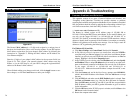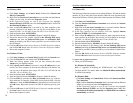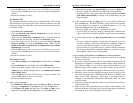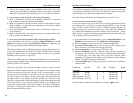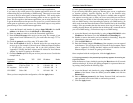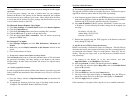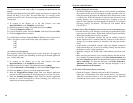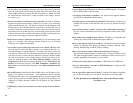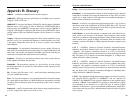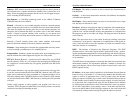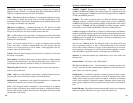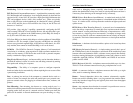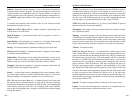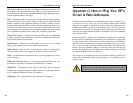
EtherFast
®
Cable/DSL Routers
91
Instant Broadband
™
Series
90
Does the Router pass PPTP packets or actively route PPTP sessions? The Router
allows PPTP packets to pass through.
Is the Router cross-platform compatible? Any platform that supports Ethernet
and TCP/IP is compatible with the Router.
How many ports can be simultaneously forwarded? Theoretically, the Router can
establish 520 sessions at the same time, but you can only forward 10 ranges
of ports.
Does the Router replace a modem? Is there a cable or DSL modem in the Router?
No, this version of the Router must work in conjunction with a cable or DSL
modem.
Which modems are compatible with the Router? The Router is compatible with
virtually any cable or DSL modem that supports Ethernet.
What are the advanced features of the Router? The Router’s advanced features
include IP Filtering, Port Range Forwarding, Dynamic Routing, Static
Routing, DMZ hosting, and MAC Address Cloning.
What is the maximum number of VPN sessions allowed by the Router?
The maximum number depends on many factors. At least one IPSec session
will work through the Router; however, simultaneous IPSec sessions may be
possible, depending on the specifics of your VPNs.
How big is the memory buffer on the Router? 1MB buffer and 512KB flash.
How can I check whether I have static or DHCP IP Addresses? Consult your ISP
to obtain this information.
How do I get mIRC to work with the Router? Under the Port Range Forwarding
tab, set port forwarding to 113 for the PC on which you are using mIRC.
If your questions are not addressed here, refer to the Linksys website,
www.linksys.com.
If all else fails in the installation, what can I do? Reset the Router by holding
down the reset button until the Diag LED fully turns on and off. Reset your
cable or DSL modem by powering the unit off and then on. Obtain and flash
the latest firmware release that is readily available on the Linksys website,
www.linksys.com.
How will I be notified of new Router firmware upgrades? All Linksys firmware
upgrades are posted on the Linksys website at www.linksys.com, where they
can be downloaded for free. The Router’s firmware can be upgraded with
TFTP programs. If the Router’s Internet connection is working well, there is
no need to download a newer firmware version, unless that version contains
new features that you would like to use. Downloading a more current version
of Router firmware will not enhance the quality or speed of your Internet con-
nection, and may disrupt your current connection stability.
Will the Router function in a Macintosh environment? Yes, but the Router’s setup
pages are accessible only through Internet Explorer 4.0 or Netscape
Navigator 4.0 or higher for Macintosh.
I am not able to get the web configuration screen for the Router. What can I do?
You may have to remove the proxy settings on your Internet browser, e.g.,
Netscape Navigator or Internet Explorer. Or remove the dial-up settings on
your browser. Check with your browser documentation, and make sure that
your browser is set to connect directly and that any dial-up is disabled. Make
sure that your browser is set to connect directly and that any dial-up is dis-
abled. For Internet Explorer, click Tools, Internet Options, and then the
Connection tab. Make sure that Internet Explorer is set to Never dial a con-
nection. For Netscape Navigator, click Edit, Preferences, Advanced, and
Proxy. Make sure that Netscape Navigator is set to Direct connection to the
Internet.
What is DMZ Hosting? Demilitarized Zone (DMZ) allows one IP address (com-
puter) to be exposed to the Internet. Some applications require multiple
TCP/IP ports to be open. It is recommended that you set your computer with
a static IP if you want to use DMZ Hosting. To get the LAN IP address, see
“Appendix F: Finding the MAC Address and IP Address for Your Ethernet
Adapter.”
If DMZ Hosting is used, does the exposed user share the public IP with the Router?
No.



